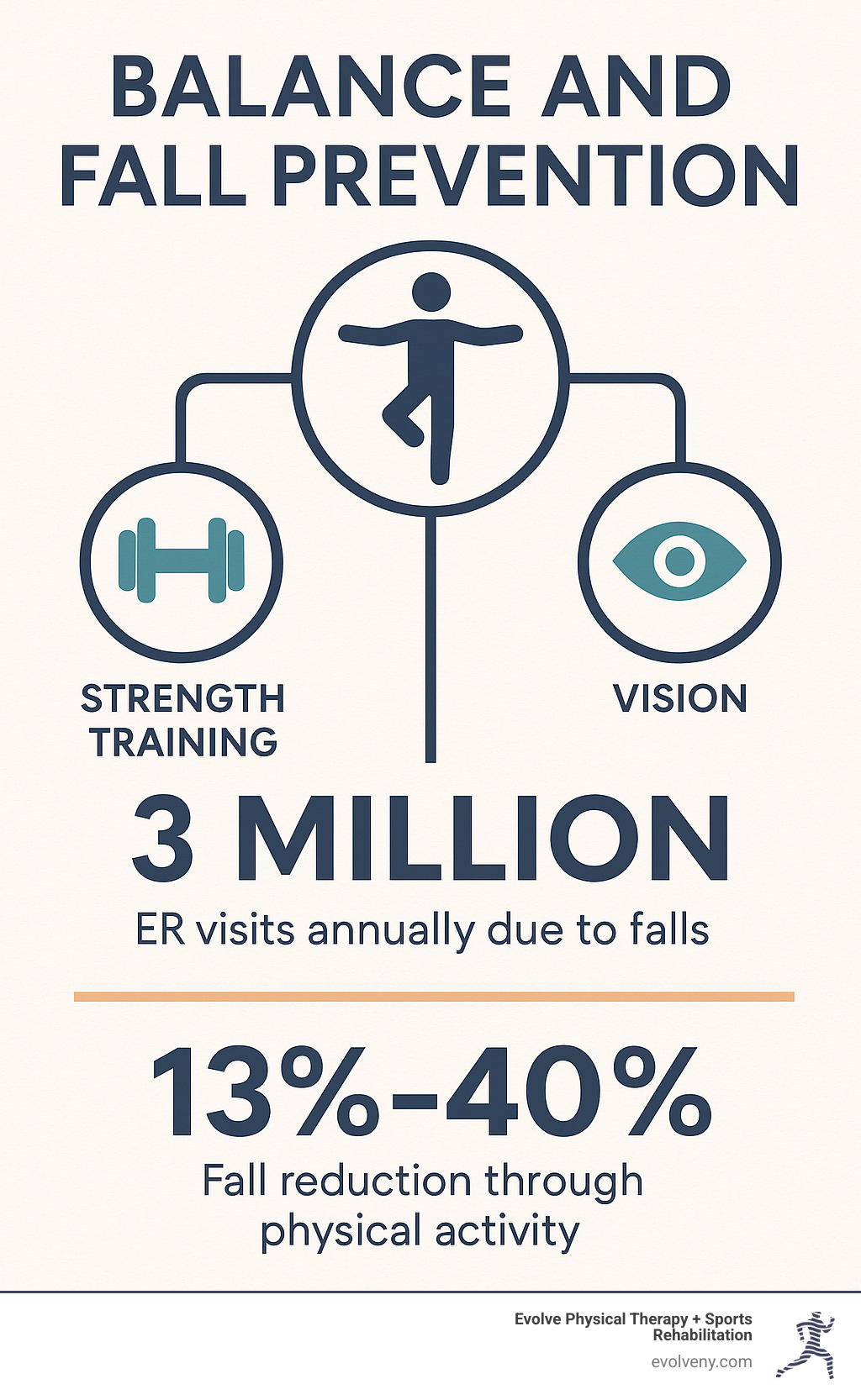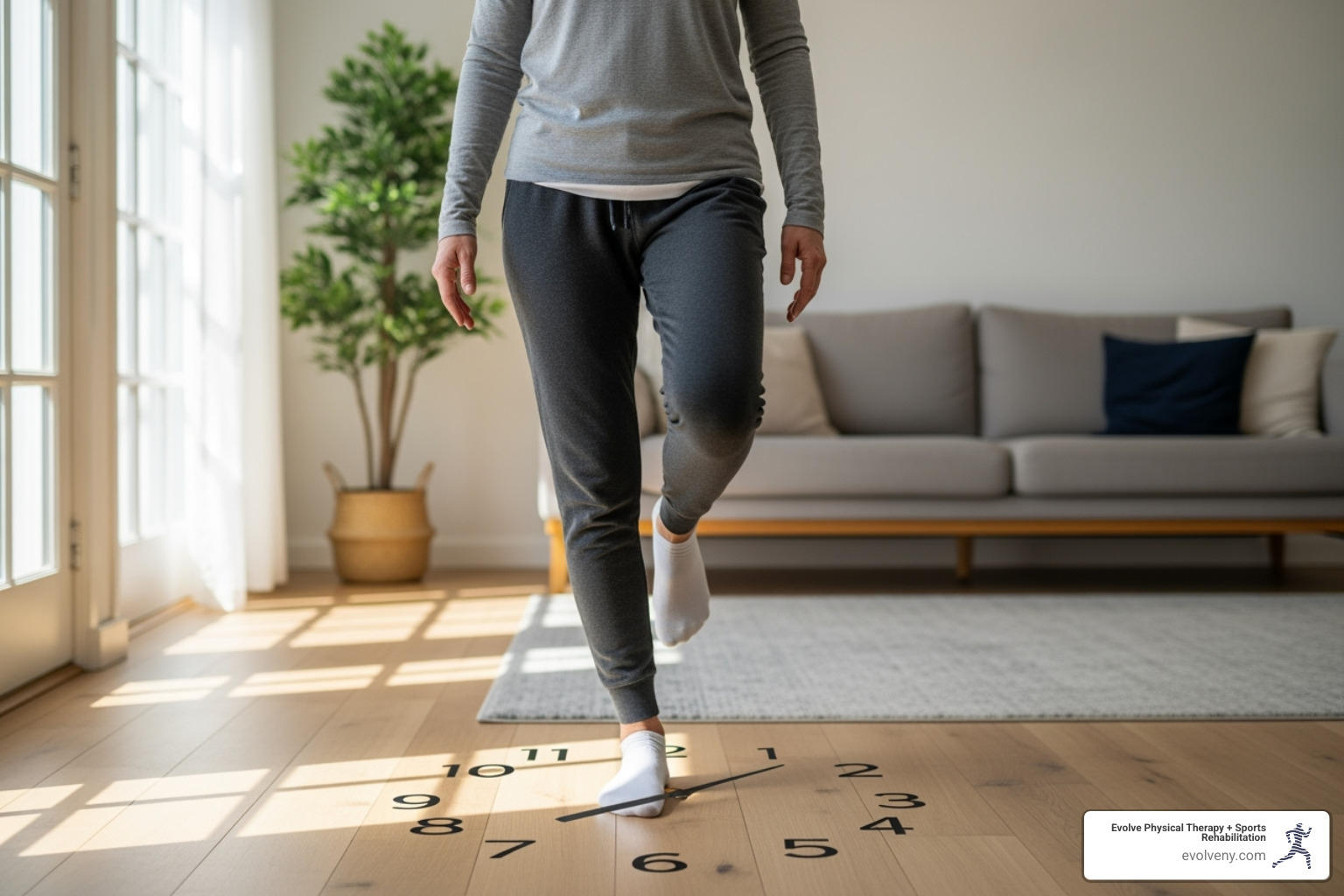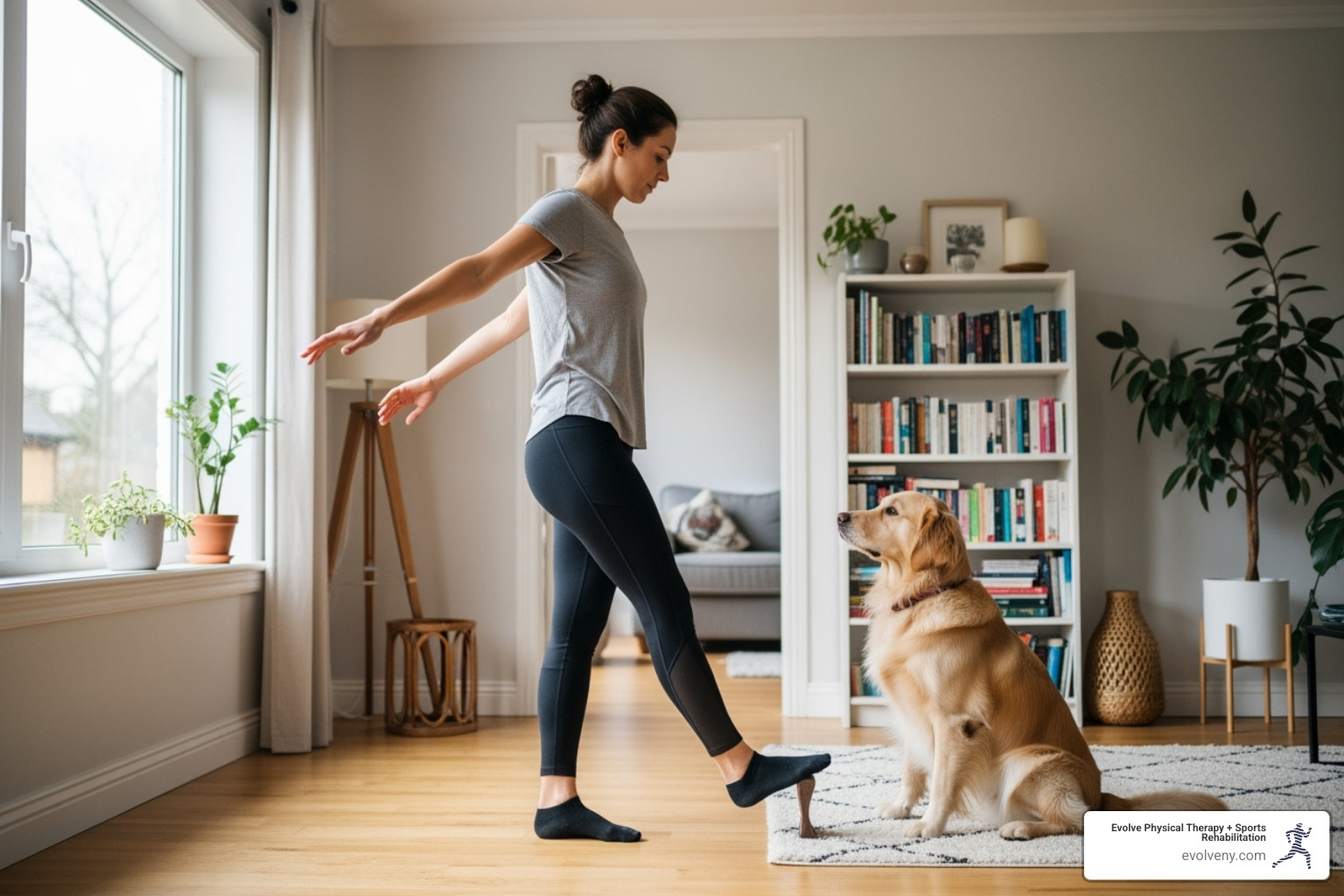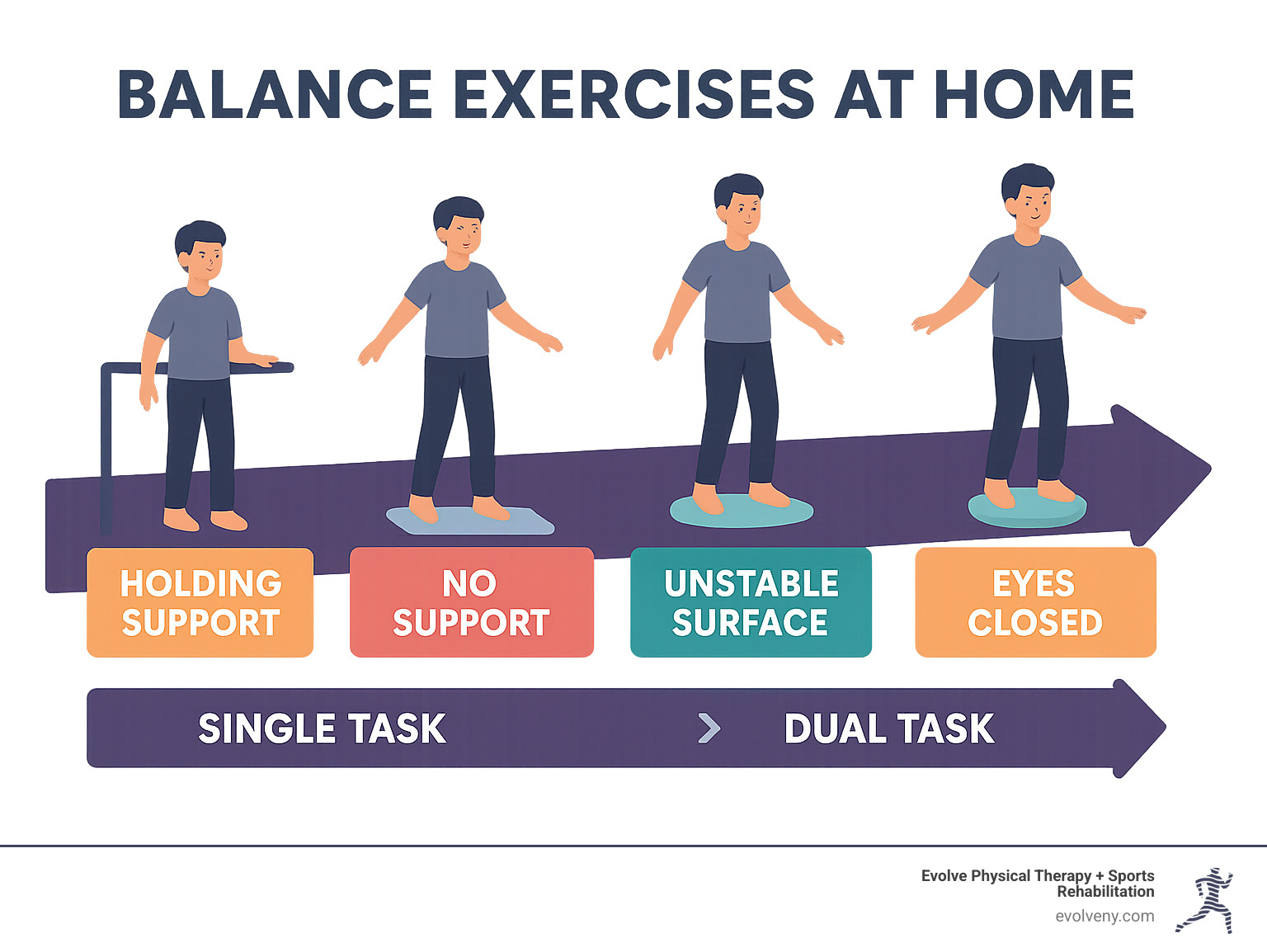Stay Balanced in Your Pajamas: At-Home Exercises for Stability
Why Balance Training Can Save Your Life (And Your Wallet)
Balance exercises at home are essential for preventing falls, which affect over 3 million older adults each year and cost an average of $35,000 per incident. The good news? Physical activity reduces falls by 13% to 40% in community-dwelling adults.
Top 5 Balance Exercises You Can Do at Home:
- One-Leg Stand - Hold for 30 seconds, 3-5 times per leg
- Heel-to-Toe Walk - Walk in a straight line placing heel directly in front of toe
- Standing Step Training - Step to different "clock positions" around your body
- Sit-to-Stand - Rise from chair without using arms for support
- Sidestepping - Step sideways along a wall or counter for support
Falls are common in people over 65 and can result in injury, loss of independence, and decreased ability to do important activities. But here's the reality: falls are preventable through proper balance training that strengthens your lower body and improves stability.
Whether you're dealing with knee pain that affects your confidence during activities or simply want to maintain your active lifestyle as you age, balance training at home offers a practical solution. These exercises require minimal equipment - just a sturdy chair or countertop for support - and can be integrated into your daily routine.
As Lou Ezrick, founder of Evolve Physical Therapy, I've spent nearly two decades helping patients regain stability and prevent falls through targeted rehabilitation. My experience treating complex cases has shown me that consistent balance exercises at home can dramatically improve quality of life while reducing injury risk.

Why Balance Training Matters
Let's be honest - nobody wants to think about falling. But the reality is stark: more than one out of four people aged 65 and older fall each year, making falls a leading cause of injury and death among seniors in North America.
These statistics represent real people losing independence, families facing emergency room visits, and significant financial strain. The average healthcare cost per fall is a jaw-dropping $35,000.
But here's where the story gets hopeful: falls are largely preventable. When you commit to doing balance exercises at home, you're taking control. Research shows that physical activity, including targeted balance training, can reduce falls by 13% to 40% in community-dwelling older adults. That's a life-changing improvement.
Think of balance training as your body's insurance policy. You're sharpening your proprioception—your body's internal GPS that tells you where you are in space. You're also improving your reaction time and strengthening the crucial lower-body muscles in your legs and hips that keep you upright.
The benefits extend beyond injury prevention. Better balance means more confidence on uneven sidewalks, navigating stairs, and enjoying activities you love without worry.
There's even a surprising bonus: balance training gives your brain a workout. The focus and coordination required provides a cognitive boost, keeping your mind sharp as your body gets stronger.
At Evolve Physical Therapy, we've seen countless patients transform their lives through consistent balance training. They go from feeling unsteady to walking with confidence and maintaining their independence. That's the quality of life everyone deserves.
Want to dive deeper into the science? Check out this Scientific research on falls prevention that backs up everything we're telling you.
Safety First: Setting Up Your Home "Balance Zone"
Creating a safe space for your balance exercises at home is key. You need an environment where you can focus on getting stronger without worrying about hazards.
The most important element is a sturdy support surface within arm's reach. Your kitchen countertop or a heavy, non-sliding dining chair works perfectly. This support is your safety buddy.
Good lighting is essential. You want to see exactly where you're stepping. Clear away any clutter, loose rugs, or curious pets. Your feet need good contact with the floor, so wear non-slip shoes or go barefoot. Avoid socks on hardwood floors.
Before you begin, spend a few minutes with gentle warm-up movements like marching in place, easy leg swings, or shoulder rolls.
Pay attention to red-flag symptoms like dizziness, sharp pain, or sudden weakness. These mean you should stop immediately. Listen to your body; the goal is gradual challenge, not pushing your limits on day one.
If you need help creating the perfect setup, our team at Evolve Physical Therapy can provide personalized guidance. You can find More info about PT safety assessments to help you get started safely.
Essential Equipment Checklist
The beauty of balance exercises at home is their simplicity. You likely already have what you need.
- A stable chair without wheels is your anchor point for many movements.
- A resistance band adds challenge to hip-strengthening exercises as you get stronger.
- A pillow or foam pad can be used to create an unstable surface once you've mastered the basics, making your muscles work harder.
- A stopwatch or timer (your phone works perfectly) helps you track your progress.
When to Call a Pro
While many can safely start balance exercises at home, sometimes expert guidance is needed. At Evolve Physical Therapy, we empower you to know when professional help makes a difference.
- Frequent dizziness or a spinning sensation needs professional attention before you start a balance program.
- If you've had a recent fall or find yourself grabbing furniture more often, a physical therapist can identify the root cause.
- Recent surgery or injury changes how your body moves. We can help you steer this transition safely.
- Conditions like Parkinson's disease, neuropathy, or inner ear problems require specialized approaches. We have experience with these, including our Rock Steady Boxing program for Parkinson's patients, featured on NBC News.
Physical therapists are movement experts who spot problems you might miss. We create personalized programs for your body and goals, helping you progress safely while addressing underlying issues affecting your balance. For more information about the benefits of working with a physical therapist, check out this resource on Scientific research on PT benefits.
Master Your Balance Exercises at Home
These carefully selected balance exercises at home target every aspect of stability and coordination, delivering real results when practiced consistently.
Before you start, remember these golden rules: Always position yourself near a sturdy support (like a counter or solid chair), move slowly and deliberately, and breathe naturally.
Start with 2-3 sets of each exercise, holding positions for up to 30 seconds or completing 10-15 repetitions. Gradual progression is key—when an exercise feels comfortable, it's time for the next challenge.

| Exercise Category | Beginner Modification | Advanced Modification |
|---|---|---|
| Support Use | Hold onto a sturdy support with both hands | Use one finger for support, or no hands |
| Surface | Perform on a firm, even surface (e.g., hard floor) | Perform on an unstable surface (e.g., firm pillow) |
| Eyes | Keep eyes open and focused on a fixed point | Close eyes (briefly and cautiously!) or turn head |
| Dual-Tasking | Focus solely on the exercise | Add a cognitive task (e.g., counting, naming objects) |
| Resistance | No added resistance | Use a resistance band (e.g., for sidestepping) |
Standing Step Training (Clock-Face) — cornerstone of balance exercises at home
This dynamic exercise improves reaction time while strengthening multiple muscle groups. Picture yourself at the center of a clock, stepping to different "hours." It's one of my favorite balance exercises at home.
Stand tall with your support surface nearby. Lift one foot and gently tap it at 12 o'clock (forward), 3 o'clock (right), 6 o'clock (behind), and 9 o'clock (left). Always return to center between taps.
Keep your standing leg slightly bent and focus your eyes forward, not down. This "eyes-up" approach trains your brain's internal balance sensors. For an added challenge, have someone call out random "hours" for you to step toward. This mimics real-life balance demands.
One-Leg Stand — classic balance exercises at home
The single-leg stand is the essence of balance training. It strengthens stabilizing muscles from your ankle to your hip and builds confidence for daily activities.
Stand tall with hands resting lightly on your support. Shift your weight to one leg and lift the other foot off the floor. Your goal is to hold for up to 30 seconds.
Game-changer: Integrate this into your daily routine. Practice while brushing your teeth or on the phone. You'll be amazed how quickly your balance improves. For more challenge, try standing on a firm pillow or folded towel.
Sidestepping With Band
Your hip muscles are the unsung heroes of balance. This exercise targets the crucial hip abductor muscles that keep you stable during sideways movements.
Position yourself along a wall or counter. If you have a resistance band, place it around your ankles or just above your knees. Keep your toes pointing straight ahead as you take 10-15 slow, controlled steps sideways (don't shuffle). Reverse and go back the other way. Maintain an upright posture. The band transforms this simple movement into a powerhouse exercise.
Sit-to-Stand Strengthener
Don't underestimate this simple, functional exercise. You use these muscles every time you rise from a chair, bed, or toilet.
Sit in a sturdy chair, feet flat and hip-width apart. Lean slightly forward and push through your heels to stand up without using your hands. Slowly lower yourself back down with complete control—no "plopping" back into the chair. This controlled descent builds significant strength.
As you progress, try a lower chair or add a soft cushion to increase the challenge.
Heel-to-Toe Walk
This classic exercise, also called tandem walking, improves your ability to walk a straight line in narrow spaces. It's like a safe, practical tightrope walk.
Stand tall with a support surface nearby. Place the heel of one foot directly in front of the toes of the other. Keep your eyes focused straight ahead.
Take 10-15 small, controlled steps forward, placing each heel directly in front of the opposite toes. A hallway is a perfect practice space. Start with light finger support on the wall, then gradually reduce your dependence on it.
Progress & Keep It Fun
The magic happens when balance exercises at home become a natural part of your daily rhythm rather than another item on your to-do list. At Evolve Physical Therapy, we've seen countless patients transform their relationship with balance training by making it enjoyable and sustainable.
Think about it this way: you're already standing while brushing your teeth, so why not practice a gentle one-leg stand? While your morning coffee brews, that's perfect timing for some heel-to-toe steps down your hallway. These small moments add up to big improvements over time.
Music can be your secret weapon for staying motivated. Try different beats and rhythms - you might find that a steady tempo helps your heel-to-toe walk, while upbeat songs make your sit-to-stands feel more like dancing than exercising. Some of our patients even create special playlists just for their balance routines.
The beauty of dual-tasking is that it mirrors real life. We rarely balance in isolation - we're usually talking, thinking, or doing something else simultaneously. When you practice balancing while chatting on the phone or watching TV, you're actually preparing your body for real-world situations.

Whether you choose to practice indoors where you feel most comfortable or eventually take your improved balance skills outside for walks in the park, progress isn't always linear. Some days will feel easier than others, and that's completely normal.

Adding Resistance & Unstable Surfaces
Once your basic balance exercises at home start feeling routine, your body is telling you it's ready for the next challenge. This is exciting news - it means you're getting stronger!
Resistance bands are fantastic tools that don't take up much storage space but pack a powerful punch. Beyond the sidestepping exercise we covered earlier, you can use them for seated leg strengthening or arm exercises while standing on one leg. The constant tension forces your stabilizing muscles to work harder.
Foam pads or firm pillows create an unstable surface that transforms even simple standing into a more challenging workout. When you stand on something slightly squishy, all those tiny muscles in your feet and ankles spring into action. Start with just 10-15 seconds and always keep your support surface within easy reach.
For those who have access to a Bosu trainer (that half-dome exercise tool), it can add variety to your routine. However, these require extra caution and are best introduced with professional guidance to ensure safety.
The key is progressing gradually. Your balance system needs time to adapt to each new challenge before you add another layer of difficulty.
Integrating Balance Into Daily Life
The most successful patients we see at Evolve Physical Therapy are those who weave balance training seamlessly into their existing routines. It's not about finding extra time in your day - it's about making the time you're already spending more beneficial.
While doing the dishes, you're already standing at the sink with a perfect support surface right there. Try shifting your weight from one foot to the other, or lift one foot slightly for 10-15 seconds at a time. Your dishes still get clean, but your balance gets a bonus workout.
Phone calls offer wonderful opportunities for movement. Instead of sitting, try some gentle heel-to-toe walking around your home. If you're having a longer conversation, practice standing on one leg for short intervals. Most people won't even know you're exercising while you chat.
TV commercial breaks are perfectly timed for mini-exercise sessions. Those 30-60 second breaks are ideal for a few sit-to-stands or some clock-face stepping. You might find yourself actually looking forward to the commercials!
Even waiting in line at the grocery store or doctor's office becomes an opportunity. A subtle heel-to-toe stance or gentle weight shifting can be done almost anywhere without drawing attention.
These small, consistent efforts compound over time. Before you know it, better balance becomes second nature, and you'll notice improvements in how confident you feel moving through your daily activities.
Frequently Asked Questions about Balance Exercises at Home
Starting a new exercise routine can feel overwhelming, especially when it involves something as important as your balance and safety. At Evolve Physical Therapy, we've helped countless patients steer these same concerns, and I want to share the most common questions we hear about balance exercises at home.
How long and how often should I train?
Here's the beautiful thing about balance training: you don't need to dedicate hours to see real improvements. Think quality over quantity. We recommend starting with just 5-10 minutes of dedicated balance exercises at home most days of the week, ideally 3-5 times weekly.
For specific exercises like the one-leg stand, aim to hold the position for as long as you comfortably can, building up to 30 seconds. Repeat this 3-5 times on each leg. Dynamic movements like sidestepping or clock-face steps work best with 10-15 repetitions per side, completed in 2-3 sets.
Remember those daily integration tips we discussed? Those count too! Practicing your one-leg stand while brushing your teeth or doing sit-to-stands during TV commercials helps you reach your training goals without feeling like you're adding another chore to your day.
What if I feel dizzy or off-balance during a set?
Your safety always comes first - no exceptions. If you experience dizziness, lightheadedness, or feel excessively unsteady during any exercise, stop immediately. Take a seat if you need to, and give yourself a moment to recover.
This is exactly why we emphasize having that sturdy support surface nearby for every exercise. Your kitchen counter or solid chair isn't just a suggestion - it's your safety net. Don't feel embarrassed about using it; even professional athletes use support when learning new movements.
If dizziness becomes a regular occurrence or is a new symptom for you, please reach out to your healthcare provider or a physical therapist. Sometimes balance issues have underlying causes that need professional attention. There's no shame in asking for help - in fact, it shows wisdom and self-awareness.
How can I make these exercises harder over time?
This is one of my favorite questions because it means you're making progress! Your body is remarkably adaptable, so once an exercise feels easy, it's time to challenge your balance system in new ways.
Reducing your support is often the first step. Gradually move from gripping your counter with both hands to using just one hand, then one finger, and eventually no hands at all. It's like learning to ride a bike - each stage builds confidence for the next.
Adding unstable surfaces creates a whole new challenge. Standing on a firm pillow or folded towel forces those smaller stabilizing muscles in your feet and ankles to work overtime. Always have your support surface nearby when trying this progression.
Closing your eyes briefly (and I emphasize briefly!) removes your visual input and forces your balance system to rely more heavily on proprioception. Only attempt this when you're very stable with eyes open, and keep that support within arm's reach.
Head movements add another layer of complexity. While holding a balance position, try slowly turning your head side to side or nodding up and down. This challenges your vestibular system - the inner ear structures that help control balance.
Dual-tasking might be the most practical progression because it mirrors real life. Try reciting the alphabet backward, counting by threes, or having a conversation while holding your one-leg stand. You'll be amazed how much harder this makes the exercise!
The key is progressing gradually and only when you feel confident and safe. There's no rush - your balance will improve with consistent practice, regardless of how slowly you advance through these progressions.
Conclusion & Next Steps
Your journey to better balance starts with a single step – and now you have the tools to take that step safely from your own living room. These balance exercises at home aren't just movements; they're your pathway to freedom, confidence, and a future where you move through life without fear.
The statistics we shared earlier might seem scary – 3 million older adults falling each year, $35,000 average cost per fall – but here's what really matters: you have the power to change those odds. Every time you practice a one-leg stand while brushing your teeth, every heel-to-toe walk down your hallway, every sit-to-stand during a commercial break, you're building a stronger, more stable version of yourself.
At Evolve Physical Therapy + Sports Rehabilitation, we've witnessed countless change stories. We've seen patients who once feared walking to their mailbox return to hiking trails, dancing at weddings, and playing with grandchildren on playgrounds. Our holistic approach goes beyond just treating symptoms – we focus on evaluation, healing, and strengthening your entire body because we know that true balance comes from the whole person working in harmony.
What makes us different? Our hands-on approach means you're never just another appointment on the schedule. We create personalized programs that fit your unique needs, whether you're recovering from a recent fall, managing a condition like Parkinson's disease through our specialized Rock Steady Boxing program, or simply want to stay active and independent as you age.
These balance exercises at home are your starting point, not your finish line. As you progress and feel more confident, you might find yourself ready for new challenges or needing guidance for specific concerns. That's where our team of expert physical therapists becomes invaluable.
Don't let another day pass wondering "what if." Your fall-free future is waiting, and we're here to help you claim it. Whether you need a comprehensive evaluation, want to learn advanced techniques, or simply have questions about your progress, we're just a phone call away.
Ready to take the next step? Visit us to learn More info about physical therapy for seniors and find how we can create a personalized plan that fits your life. Because at Evolve Physical Therapy, we don't just help you get better – we help you evolve into the strongest, most confident version of yourself.
Your balance journey starts now. Let's evolve together!


